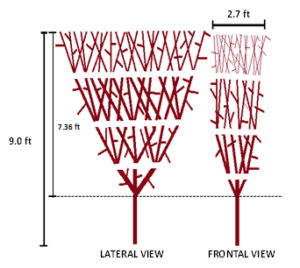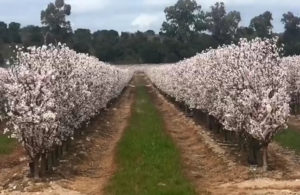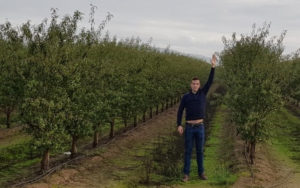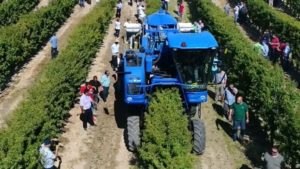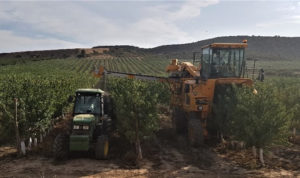Introduction, objectives and description
The Super High Density (SHD) or Hedge is a training system developed in Spain over the last 25 years for olive production. Based on a similar concept the SHD started to be developed in commercial orchards of almond 9 years ago, with a current world surface of 12,000 acres in Spain, Portugal and Italy.
The main objectives of this system are to get early yields through the intensification, with almost full mechanization of labors (pruning, harvest), and high efficiency in the use of water, pesticides, fertilizers, labor; at the end a sustainable system for future almond production.
The hedge is characterized by small trees, grated on the dwarfing Agromillora’s rootstock Rootpac-20, adapted to mechanical pruning and over-row harvest. Common planting distance used is 10 ft between rows and 4 ft between trees, resulting in a planting density of 1,089 trees/acre (2,691trees/ha). Canopy dimensions are 7.36 ft (tall) x 2.7 ft (width), as illustrated in Figure 1. Also, in this figure, lateral and frontal view of canopy tree is showed. From the first orchard planted in Spain in 2010 to now, interrow distances, have been reduced in order to optimize light interception and increase yield. Considering the dimensions of hedge exposed in Figure 1, in full crop trees yields of 2,500 lb/acre have been achieved in Spain.
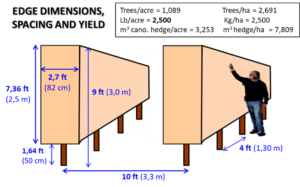
Planting costs of hedge and total cost of production
In this study we have applied the same concept and methodology developed in Spain over the last 10 years in terms of planting distances adjustment, fertilization, pruning, yields, etc. but considering the costs of production of almond (land, water, trees, fertilizers, labour, energy, etc.) in California. The further development of SHD system in California based in this model will provide interesting and useful information to validation of this system in different climatic-edaphic conditions.
Total cost of planting hedge per acre are exposed in Table 1. This cost includes: plot preparation, soil survey, irrigation system, potted trees, small bamboo 3.28 ft, planting and royalties. To determine the planting cost we have considered the spacing exposed in Figure 1 (10 x 4 ft), resulting a planting density of 1,089 trees/acre. As exposed in Table 1 the main cost are the trees and the irrigation system.
The second step is to calculate the operational cost and the total cost per year, including all the costs of different concepts as: pruning (hand first year, mechanical after), interrow soil maintenance, herbicides application in the row, treatments (fungicides + insecticides), irrigation water (considering 3 acre-foot and 150 $US/acre-foot, harvest by over-row harvester, administration and other. All these costs are exposed in Table 2. For soil maintenance we consider 3 times of mower per year and 3 times of herbicide application in the row 3.3 ft wide. We consider the application of fertilizers by drip irrigation. It’s based on a triple complex 8N-14P205-10K20, combining it with the application of chelate containing different micronutrients as Fe, Zn and Mn. Total amount per acre and year are exposed in Table 2. Water irrigation supply per year range from 1 to 3 acre-foot depending on the tree age (Table 2).
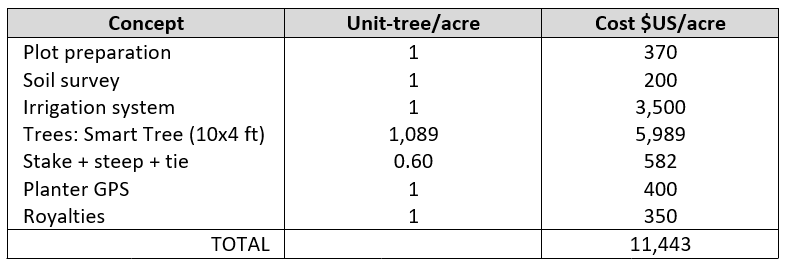

From Table 1 we get the cost of planting almond in SHD. From Table 2 we obtain the total cost per year from year one to full yield, including both operational cost and overhead. During full yield period total cost is 2,957 $US/acre. To determine the cash flow during the lifespan of the orchard (from year 1 to year 20) we have considered the next concepts:
- Planting cost (Table 1).
- Operational cost (Table 2).
- Expected yields from year 1 to year 20 (Figure 2).
- Kernel price: 2.5 $US/lb kernel. https://www.merlofarminggroup.com/almonds/California%20Inshell
Cash flow values from year to year 20 were exposed in Table 3, considering kernel price of 2.5 $US/Lb. Taking in account these data and considering also a lower price (2.5) and a higher price (3.0 $US/lb), we calculate the economical index corresponding to each of three scenarios. The results obtained are exposed in Table 4. Current price of almond is around 2.6 $US/Lb. Economical index exposed in Table 4 show the clear effect of almond price on the profitability of the investment.


Economical Index
Economical Index corresponding to different almond prices (2.0, 2.5 and 3.0 $US/Lb) and considering 150 US/acre-foot, are exposed in Table 4. The range values of IRR ranges from 9.8% to 19.0%.

Total cost of almond production plus processing exposed in Table 2, are represented in Figure 3 (left) resulting 1.18 $US/Lb. If we include the overhead (1,000 $US/acre) we have the total cost of production for almond produced in California using the SHD system. This total cost is represented in Figure 3 (right) and accounts 1.58 $US/kg.
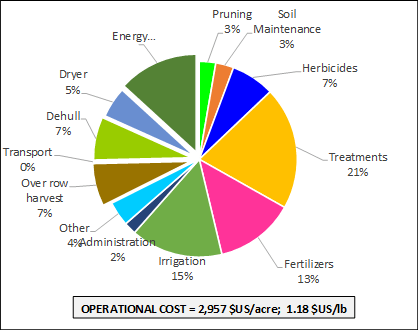
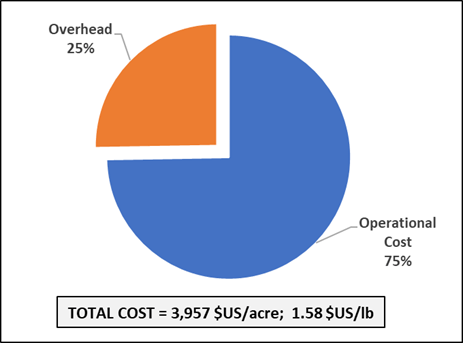
PHOTOGRAPHIC ANNEX
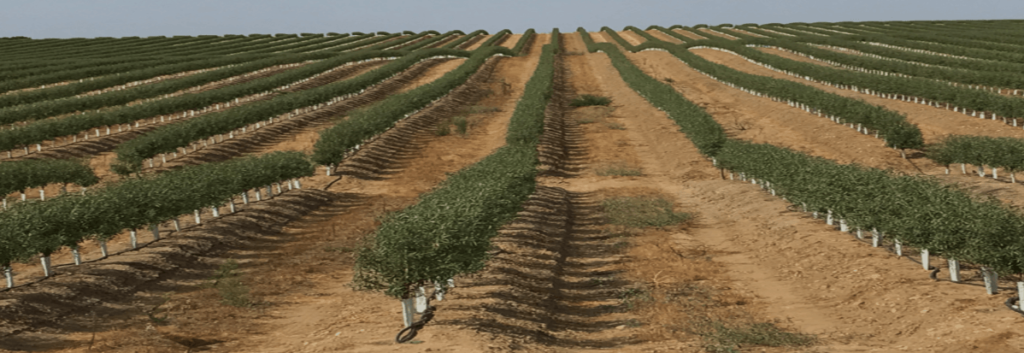
Second year almond orchard of ‘Lauranne’/Rootpac-20 in Extremadura (Spain).
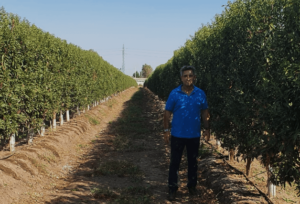
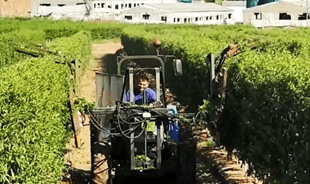
Third year orchard of ‘Soleta’/Rootpac-20 at blooming time (left) and after harvest in Andalucía (Spain).
Two different over-row harvesters and harvest systems: New Holland (left), Gregoire (right).
